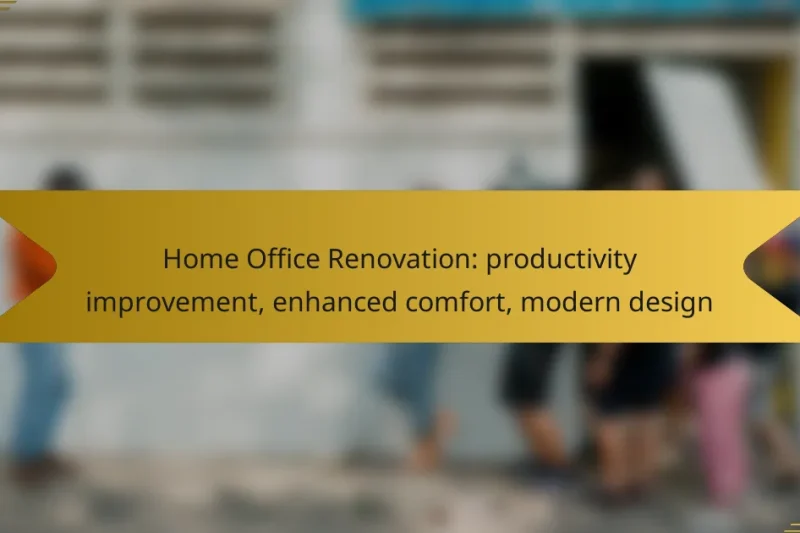Upgrading to a modern fireplace can transform your living space with its sleek design and advanced … Fireplace Upgrade: modern design, improved efficiency, enhanced warmthRead more
Home renovations encompass a variety of projects that can transform a space, improve functionality, and boost property value. From kitchen remodels to exterior upgrades, each type of renovation serves distinct purposes tailored to homeowners' needs. Understanding the costs and benefits associated with these renovations is essential for making informed decisions and maximizing your investment.
Siding Replacement: enhanced insulation, aesthetic appeal, low maintenance
Siding replacement is a valuable investment for homeowners, offering improved insulation, enhanced aesthetic appeal, and low … Siding Replacement: enhanced insulation, aesthetic appeal, low maintenanceRead more
Basement Finishing: cost breakdown, potential ROI, design choices
Finishing a basement can be a transformative project for homeowners, with costs typically ranging from $20,000 … Basement Finishing: cost breakdown, potential ROI, design choicesRead more
Home Office Renovation: productivity improvement, enhanced comfort, modern design
Renovating your home office can lead to significant improvements in productivity and comfort, transforming your workspace … Home Office Renovation: productivity improvement, enhanced comfort, modern designRead more
Home Office Renovation: productivity boost, comfort, modern amenities
Renovating your home office can lead to a remarkable boost in productivity by transforming it into … Home Office Renovation: productivity boost, comfort, modern amenitiesRead more
Landscape Overhaul: improved aesthetics, outdoor functionality, increased value
A landscape overhaul can transform outdoor spaces by enhancing their visual appeal and functionality. By integrating … Landscape Overhaul: improved aesthetics, outdoor functionality, increased valueRead more
Window Replacement: cost analysis, energy savings, installation expenses
Replacing windows is a significant investment that can vary widely in cost depending on location, materials, … Window Replacement: cost analysis, energy savings, installation expensesRead more
Roof Replacement: enhanced durability, energy savings, aesthetic appeal
Roof replacement is a vital investment that not only boosts the durability of your home but … Roof Replacement: enhanced durability, energy savings, aesthetic appealRead more
Living Room Update: modern design, enhanced comfort, increased enjoyment
Updating your living room with a modern design can significantly enhance both comfort and enjoyment. By … Living Room Update: modern design, enhanced comfort, increased enjoymentRead more
Basement Finishing: additional living space, increased property value, versatile usage
Finishing a basement is an effective way to transform an underutilized area into valuable living space, … Basement Finishing: additional living space, increased property value, versatile usageRead more
What are the most common types of home renovations?
The most common types of home renovations include kitchen remodels, bathroom upgrades, basement finishing, room additions, and exterior renovations. Each type serves different purposes, from improving functionality to enhancing aesthetics and increasing property value.
Kitchen remodels
Kitchen remodels are among the most popular home renovations, often focusing on updating appliances, cabinetry, and countertops. A typical kitchen remodel can range from a few thousand to tens of thousands of dollars, depending on the scope of work and materials chosen.
When planning a kitchen remodel, consider the layout and flow of the space. Open-concept designs are trending, but ensure that the kitchen remains functional and meets your cooking needs. Prioritize high-quality materials that can withstand daily use.
Bathroom upgrades
Bathroom upgrades can significantly enhance comfort and functionality, with common improvements including new fixtures, tile work, and lighting. Costs for bathroom renovations can vary widely, often falling between a few thousand to over twenty thousand dollars.
Focus on maximizing space and storage in smaller bathrooms. Features like double sinks or walk-in showers can add luxury and convenience. Always check local plumbing codes to ensure compliance with regulations during upgrades.
Basement finishing
Finishing a basement transforms an underutilized space into a functional area, such as a family room, home office, or guest suite. This type of renovation typically costs between ten thousand to fifty thousand dollars, depending on the level of finish and design complexity.
Before starting, assess moisture levels and ensure proper insulation and ventilation. Consider adding egress windows for safety and natural light. A well-finished basement can increase your home's overall value and livability.
Room additions
Room additions expand the living space of a home, providing extra bedrooms, offices, or recreational areas. The cost for room additions can range significantly, often between twenty thousand to a hundred thousand dollars, depending on size and design.
When planning a room addition, check local zoning laws and building permits. It's essential to maintain the architectural style of your home for a cohesive look. Hiring an experienced contractor can help navigate these complexities and ensure quality work.
Exterior renovations
Exterior renovations improve a home's curb appeal and can include siding replacement, roof repairs, and landscaping. These projects typically range from a few thousand to tens of thousands of dollars, depending on the materials and extent of the work.
Focus on energy efficiency when upgrading windows and doors, as this can lower utility bills. Regular maintenance of the exterior can prevent costly repairs in the future. Always consider the local climate when selecting materials to ensure durability and longevity.
How much do different home renovations cost?
The cost of home renovations varies widely based on the type of project, materials used, and location. Understanding the average costs can help homeowners budget effectively and make informed decisions.
Average kitchen remodel costs
Kitchen remodels typically range from low tens of thousands to mid-hundreds of thousands of USD, depending on the extent of the changes. A minor remodel may cost around $20,000, while a major overhaul can exceed $50,000.
Key factors influencing kitchen remodel costs include cabinetry, countertops, appliances, and labor. Homeowners should prioritize their needs and consider mid-range materials for a balance between quality and price.
Average bathroom renovation costs
Bathroom renovations usually fall between $10,000 and $30,000, with upscale projects potentially reaching $50,000 or more. A simple update, like new fixtures and paint, can be done for around $5,000.
Considerations for bathroom costs include tile, plumbing, and fixtures. Homeowners should assess their space and choose durable materials that fit their budget while enhancing functionality.
Cost of adding a room
Adding a room can cost anywhere from $20,000 to over $100,000, depending on the size and complexity of the addition. Factors such as foundation work, permits, and design can significantly impact the final price.
Homeowners should evaluate local zoning laws and building codes before starting an addition. It's essential to work with a qualified contractor to ensure the project meets all regulations and is completed to a high standard.
Basement finishing expenses
Finishing a basement generally costs between $20,000 and $50,000, influenced by factors like insulation, flooring, and plumbing. A well-finished basement can add significant value to a home.
When planning a basement renovation, consider moisture control and egress requirements for safety. Investing in quality materials can prevent future issues and enhance the overall living space.
What are the benefits of home renovations?
Home renovations offer numerous advantages, including increased property value, improved energy efficiency, and enhanced aesthetics. These benefits can significantly impact your living experience and financial investment.
Increased property value
One of the primary benefits of home renovations is the potential for increased property value. Upgrades such as kitchen remodels, bathroom renovations, and adding square footage can yield a high return on investment, often recouping a significant portion of the costs upon resale.
When planning renovations, consider the local real estate market. In areas where home values are rising, even minor improvements can lead to substantial increases in property worth. Aim for renovations that appeal to potential buyers in your region.
Improved energy efficiency
Renovations can enhance a home's energy efficiency, leading to lower utility bills and a reduced carbon footprint. Upgrading insulation, installing energy-efficient windows, and using modern appliances can significantly decrease energy consumption.
When focusing on energy efficiency, consider the initial investment versus long-term savings. For example, energy-efficient windows may have a higher upfront cost but can save hundreds of dollars annually on heating and cooling. Look for products that meet local energy standards to maximize benefits.
Enhanced aesthetics
Home renovations can dramatically improve the aesthetics of your living space, making it more enjoyable and functional. Fresh paint, updated fixtures, and modern layouts can transform the overall appearance and feel of your home.
To achieve the best results, prioritize renovations that align with your personal style and the architectural integrity of your home. Simple changes like landscaping or new flooring can create a welcoming atmosphere without extensive investment. Consider consulting with a designer for ideas that enhance both beauty and functionality.
What factors should be considered before renovating?
Before renovating, it's crucial to evaluate several key factors that can significantly impact the success of your project. These include budget constraints, potential return on investment, and adherence to local building codes.
Budget constraints
Establishing a clear budget is essential before starting any renovation. Consider not only the costs of materials and labor but also unexpected expenses that may arise during the project. A good rule of thumb is to allocate an additional 10-20% of your budget for contingencies.
When setting your budget, prioritize renovations that align with your financial capabilities. For instance, minor updates like painting or landscaping can be more manageable than extensive structural changes.
Return on investment
Understanding the potential return on investment (ROI) is vital when planning renovations. Certain projects, such as kitchen or bathroom remodels, typically yield higher returns compared to others, like adding a swimming pool. Research local market trends to determine which renovations are most valued in your area.
To maximize ROI, focus on improvements that enhance functionality and appeal. Simple upgrades, such as new fixtures or energy-efficient appliances, can significantly increase your home's value without a hefty price tag.
Local building codes
Compliance with local building codes is a critical factor in any renovation project. These regulations ensure safety and quality standards are met, and failing to adhere to them can result in fines or the need for costly modifications. Always check with your local building authority before starting renovations.
Familiarize yourself with the specific codes that apply to your project, as they can vary widely by location. For example, some areas may have strict guidelines regarding electrical work or structural changes, which could impact your renovation plans.














